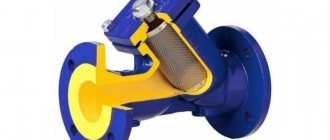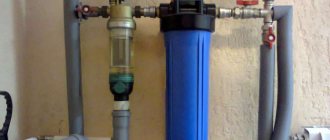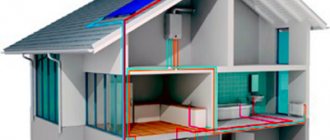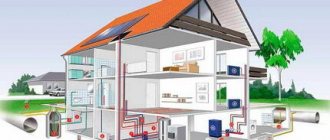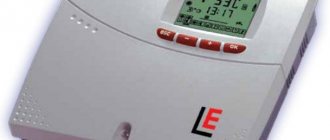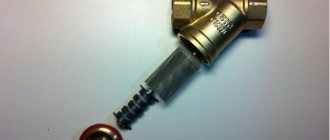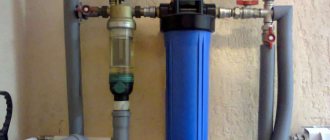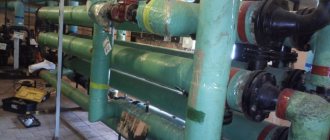Why is untreated water dangerous for a gas boiler?
Why do you so desperately need a water filter in front of a gas boiler? What filter? What impurities have the most negative effect on boiler equipment? Actually, impurities in water can be very different. After all, there can be several sources of water:
- Central water supply;
- Nearest surface source;
- Underground source.
Each source has its own impurities, some more harmful than others, some others. But if you bring all the harmful impurities into one table, you’ll get something like this:
| Equipment | Impurities in water |
| Boiler room | Solids - garbage, sand Smell, color Metal salts Lime salts Bacteria, viruses Dissolved gases |
A filter in front of the heating boiler is necessary, and more than one. It all depends on two factors - the state of the water and financial capabilities. Using untreated water will actually cost the consumer much more. Danger lies even in seemingly good water coming from a central source. Such water involves all stages of purification, except one - softening. And lime water is especially destructive for a gas boiler!
What special negative does she have? Is it necessary to install a filter in front of a gas boiler? If the boiler is steam, then definitely! The steam must be crystal clear, purified, including from dissolved gases. When heated, limewater forms a dense coating on surfaces. And it's not easy to remove. But most importantly, it works as an insulator. Heat passes through such a coating, even a very thin one, very poorly. The surface under such a load suffers terrible overloads and either burns out or explodes. Therefore, a water softening filter in front of a gas boiler is a mandatory element of water treatment if the water is too hard.
Hard water and scale
There are two problems in terms of softening. Both hard water and the resulting scale cause damage to the system. The worst thing for the boiler is the result of lime water - scale. All cracks, scratches, breaks are due to the heat transfer block to the water. As for hard water, it brings negative consequences to human health both directly and indirectly.
There are several areas where water leaves its mark before plaque forms. This includes washing and surface treatment. The secret is hidden in the contact of this type of water with any detergents. Lime salts react very poorly with washing alkalis. As a result, the dissolution of detergents deteriorates and they form a stone-like sediment in contact with salts. Every housewife who has ever washed a down jacket in hard water has seen what comes of this. There is a grayish-whitish coating with streaks over the entire surface of the jacket or coat. Which can then be washed, but this only makes it worse, stains appear in another place. And to rinse such a large thing with lime-tainted water, the costs are much higher. And divorces are still treacherous.
It turns out that the washing seems to be going well, but the laundry remains dirty, many times more water and detergents are used, and the result is even negative. People with ulcers or allergies are not recommended to drink lime water. Just like swimming in such water. It can cause irritation and allergies.
If you don’t have a softener, you need to get rid of scale and do it with enviable consistency. If deposits are not removed from the internal surface of a double-circuit boiler in time, it will burst, the household appliance will burn out, and the pan will become unusable ahead of time. That’s why we carried out various preventive cleanings of the gas boiler from scale and major cleanings. Today, with such development of the softening sphere, it is enough to install one or two softeners in an apartment to protect household appliances.
Root causes of boiler failure
As already mentioned, if the water in the system is limestone, then it is the first reason for the breakdown of boiler equipment. This is the main problem in thermal power engineering. Of course, a coarse filter in front of the boiler is just as important, but this is what will be installed by default if the water is supplied without primary purification, but softening may be delayed, the system is not cheap, and the boiler has not yet cracked. Unfortunately, a certain degree of carelessness in this regard still exists.
Another reason for boiler breakdowns is improper operation and improper care of boiler surfaces. And of course, poor quality water. There are no other root causes of breakdowns other than manufacturing defects. Any untreated water will instantly cause damage. Debris will clog the pipes, damage the surface, and the boiler will be irrevocably damaged. Therefore, expensive boiler equipment requires appropriate care. The consequences of hard water are the saddest, albeit in the long term.
Strainer filter for heating: design, types, installation
Filter for mechanical cleaning of coolant.
A mesh filter for heating is a device used to clean the coolant from various solid mechanical particles (scale, rust, scale, sand and other sludge) circulating through the heating system.
Design
Dirt trap with drain cock.
The design of the mesh filter consists of the following parts:
- Brass, bronze, cast iron or stainless steel body. There are models with both flange and coupling connections to the pipeline. Brass and bronze are used to make filters ranging from ½ to 2 inches in diameter. Cast iron and steel are typically used to produce filters with a diameter of 1½ inches, but smaller models are also available;
- Cork. Connects to the housing either with a flange or thread. Allows you to remove the filter element for further cleaning or replacement. To avoid leakage, the plug is equipped with a sealing gasket (ring);
- The filter element is in the form of a fine-mesh cylindrical mesh. The mesh is made of stainless steel and connected to each other using electric contact welding.
Universal coupling filter Valtec VT 386: 1) brass body with nickel plated; 2) brass plug with nickel plated; 3) stainless steel mesh; 4) sealing ring.
Some filter models are equipped with magnets that attract iron-containing particles.
Mesh filters can vary in degree of purification:
- rough cleaning (cell sizes from 300 to 500 micrometers);
- finer cleaning (ability to retain particles with a size of 100 microns).
Operating principle
The steel mesh located inside the housing completely covers the passage opening. As a result of this, the coolant passing through the mesh leaves solid particles of contaminants on its walls.
Strainer DN40 installed on the return line in front of the gas boiler.
Cleaning the filter element
The first sign that the filter needs to be cleaned is increased hydraulic resistance in the system, which is recorded by pressure gauges. A clean mesh also creates resistance, but it is nothing compared to the resistance created by a dirty mesh.
It is recommended to wash the dirty mesh with water using a brush with stiff polymer bristles. To begin with, you should shut off the flow of coolant to the section of the pipeline with the filter (turn off the circulation pump and close the shut-off valves). Next, unscrew the plug, remove and clean the mesh. If it is impossible to clean the mesh, it is recommended to replace it with a new one.
Important! The mesh filter will fully perform its function only if the filter element is evenly installed in special grooves. Therefore, when replacing a worn mesh with a new one (or installing an old one after cleaning), you must ensure that its edges do not bend.
Mesh filters for cleaning coolant.
There are types of mesh filters that allow you to remove contaminants without disassembling the device. As a rule, the design of such models includes: a pressure gauge (showing the degree of filter contamination); drain valve with the ability to connect an outlet hose; two-layer filter mesh (the first layer traps large particles, the second smaller ones).
Which filter to put in front of a gas boiler?
Any heating systems engineer, any owner of a house with a private boiler room asks the question - what kind of heating filter to put in front of the boiler? Which system should I choose if the boiler is gas or double-circuit? Where do you even start when solving such an important problem? First of all, you need to select a company that will develop, compose and commission a water purification system for the proposed boiler house. This expensive option will definitely have to be chosen during the initial water intake. Solving problems with boiler breakdowns and replacing incorrect cleaners will cost more later.
If the water is supplied from central water supplies, or it does not appear to be heavily spoiled by the benefits of civilization, you need to start by checking the composition of the water. The analysis does not cost a lot of money, but it allows you to very accurately compile a list of the necessary water purifiers, and will determine not only the composition, but also the capacity of future treatment facilities. To soften water, sometimes you need at least two devices.
The most commonly used complexes are a combination of mechanical cleaning with softening, iron removal and disinfection. Options for stages can be added or removed depending on the impurities in the water.
Which filter to put in front of a gas boiler? There are no special differences for gas or steam boiler houses. Unless water purification for a steam boiler room should be more thorough. A gas boiler does not require such fine cleaning. Therefore, if the water is simply chalky, then one powerful softener will be enough and, best of all, not just a softener, but a purifier. A magnetic or electromagnetic softener is just right for this case.
Electromagnetic filter AquaShield
To soften water in a boiler room, it is best to use a good electromagnetic filter, which is what AquaShield is. Why is the electromagnetic effect on water so praised, and why is it so much preferable to the same ion exchange? It will perfectly protect boiler equipment from hard water. It works without additional costs and exhausting maintenance, like the same ion exchange filter with all its replacements and restorations. But besides this, AquaShield guarantees practically clean internal surfaces of the equipment, without the involvement of human labor and disassembly of the equipment.
This device works by irradiating water with a magnetic force field. The strength of the latter is supported by a good electrical processor. This pair allows you to achieve a long-lasting effect with little effort. The softener-cleaner is not afraid of pressure and temperature changes. In this case, water softening occurs in such a way that the transformed salts perfectly clean the surfaces of the equipment from old sediment. Yes, this happens slowly, but this process is ongoing.
But you won’t be able to obtain drinking water with the help of one such purifier; you will have to supplement it with something. But in the boiler room, potable quality is not required. For industrial needs, the filter clearly performs all the tasks assigned to it. With such a device, the question of which filter to put in front of the boiler is not worth it.
Mud filter or coarse filter
If water for the boiler room is taken from any type of primary source, then it will definitely not be possible to avoid using a coarse filter in front of the boiler. Any water, even artesian water, contains various types of debris and suspended matter. Even small ones, they can harm the operation of boiler equipment. Damage surfaces, accumulate somewhere, begin to rot, or contribute to the development of rust. That’s why even a banal mud scavenger will be a great help in such a matter.
Everything again depends on the fractional nature of the pollution and the degree of this pollution itself. You may have to install not only coarse filters, but also a sorption device that will help clean the gas boiler from scale, as well as cope with odors and very fine dust. All this also needs to be removed from the water so as not to damage the boiler equipment and subsequently the heating equipment.
Polyphosphate filter
To soften water and protect against scale, a polyphosphate filter is often recommended. It works similar to ion exchange, on the same principle. Only the sodium salt is washed out here more slowly than in ion exchange cartridges, and without replacement, such a device can last almost twelve months. If desired, it can also be used for small boiler rooms, so as not to buy two cleaning devices. But you will have to take care of it, change filters, and check the polyphosphate consumption. That is, there are some conveniences for the consumer.
But such a basis as ion exchange helps to obtain good soft water, including drinking water. But at the same time, the internal surfaces from the old lime deposits will have to be cleaned manually. But then you won’t have to install any filters for drinking water in the kitchen.
Varieties
To reduce the risk of boiler breakdown, increase the accuracy of measuring instruments and ensure a long service life of the equipment, it is important to understand the main types of devices and choose the right one.
Polyphosphate
Polyphosphate units are considered a budget option for pre-purification and softening of water entering the boiler.
The operating principle of such a device is to pass liquid through a flask filled with special crystals. They ensure the formation of a protective film on the inner walls of the boiler and also slow down the formation of scale.
Photo 1. Polyphosphate filter for a gas boiler, filled with special crystals. They slow down scale formation.
The devices have a simple design:
- drain;
- flask;
- filler;
- lid.
The liquid enters the flask with filler through the lid, where it is passed through polyphosphate crystals. Next, it goes through the drain into the gas boiler tank.
Any device of this type requires periodic replacement of the filler - sodium salt crystals. As a matter of fact, this is the only difficulty in servicing them. The average lifespan of such a treatment plant is up to one and a half years.
Electromagnetic or magnetic for softening hard water
Electromagnetic devices are expensive, but the price is completely justified: the installation lasts a long time and allows you to obtain perfectly clean water at the output.
The principle of operation is that when the liquid passes through the flask, the salts in it disintegrate. Thus, scale will not settle on the walls of the boiler. Instead, the filter itself will be clogged with tiny salt particles, which is periodically washed.
Photo 2. Three magnetic filters for a heating system boiler; the scale in them breaks down into tiny particles.
Another characteristic is that under the influence of electromagnetic radiation, not only does the scale disintegrate into small particles, but also a thin film is formed that covers the boiler heat exchanger. Thanks to this, it remains protected and does not corrode for a long time.
We should not forget that electromagnetic and magnetic devices are different installations. At the heart of both is a magnet.
Attention! Electromagnetic devices are more powerful because they require connection to an electrical network. Ideal for gas boilers, as they perfectly soften water of any temperature. Magnetic installations are less strong and are not recommended for use with gas boilers if the water hardness is too high.
Magnetic devices consist of a metal case, inside of which there are a large number of strong magnets. Electromagnetic devices are additionally equipped with an electric drive, the operation of which allows the effect of magnets to be greatly enhanced.
Cartridge for cleaning
Cartridge devices have low throughput. The following device types exist:
- Mechanical - traps small debris. Such devices need to be cleaned frequently, and they do not soften the water.
- Coal - purify water due to activated carbon, which acts as a filler. If you do not change it in time, the water will become even more contaminated as a result of passing through the filter.
Photo 3. Four low-flow cartridge filters are needed to purify the water.
- Ion exchange cartridge devices are considered the best, as they change the hardness of water by entering into a chemical reaction with calcium and magnesium ions.
- Osmotic - allow molecules of water and gas to pass through them. This allows you to clean the liquid from metal impurities and harmful microorganisms, but it will not be possible to soften the water by installing such a filter.
- Membrane - purify water from debris and impurities, but do not soften it.
Important! Cartridge filters are not suitable for gas boilers (with the exception of ion exchange devices). They are more focused on purifying water that is intended to be drunk.
What is suitable for a double-circuit boiler?
Let's start by looking at the features of a double-circuit boiler. Should the filter in front of the double-circuit boiler be some kind of special or not? Dual-circuit means that it has not one type of heating, but two. It heats the water, not only that which is in the heating system, but also that which is supplied to the house as hot water. How does this affect filter selection? Well, first of all, because the quality of the water is still potable, because... The family will use hot water in the kitchen and for bathing. This means that the quality of cleaning must be appropriate. The second feature is greater water consumption, because... it serves two purposes at once, which means the filter cleaner should be more powerful.
Therefore, for such boilers it is necessary to either install one more powerful polyphosphate filter, or combine two devices - electromagnetic and ion exchange, each for its own circuit.
What about the heating system?
Heating can be with a hot water boiler, it can be gas, it can be steam. What kind of filter should there be in the heating system in front of the gas boiler? This is where knowledge about electromagnetic advantages comes in handy. An electromagnetic softener is most suitable for a gas hot water boiler. Safe to maintain, absolutely unpretentious and easy to use, the filter for cleaning the heating system will purify the water very efficiently to the desired degree of softness. And if you put it in combination with a coarse cleaner, then they will work for many years. After all, the magnetic effect is practically not lost over the years.
Recommendations for selection
Before buying a filter for a gas boiler, you should consult with a specialist who will recommend a suitable device and give recommendations.
General recommendations for selection:
- If you plan to use a gas boiler frequently, it is better to give preference to an electromagnetic device: it will not allow scale to accumulate on parts, and will also work for a long time without additional maintenance.
- If funds are limited, you can use a polyphosphate filter or a cartridge ion exchange filter.
But it should be remembered that you will have to constantly change the filler and the service life of these filters is shorter compared to electromagnetic ones.
- When choosing a device, you need to immediately decide where to install it. Sometimes installation requires a large space, which is not always possible.
- Be sure to make sure you have a warranty card. Good manufacturers of such devices never sell their product without providing a guarantee for it.
- It is preferable to purchase devices from well-known brands, since such products are more difficult to counterfeit. Often, unscrupulous sellers sell counterfeits under the guise of a well-known brand at a very low cost, so you should also pay attention to differences in prices for filters from the same manufacturer.
- If the tap water is hard, then in order to better protect the gas boiler, it is recommended to buy two filters at once, focused on different degrees of water purification.
- To simultaneously soften the liquid and protect the internal parts of the boiler from possible damage, it is better to use devices that soften water and have the ability to create a protective film on the heating elements.
If you follow all the recommendations described above, you can choose a device that is suitable for the price and technical characteristics.
Types of devices
Based on the degree of purification, mud collectors are classified into several types.
Rough cleaning. What is a sediment filter?
The coarse cleaning device is an angular mesh filter with a mesh of up to 300 µm-microns. The device is also equipped with a drain in which dirt accumulates. This product is designed to clean coolant from large and small fractions.
Design
Depending on the design, there are several types of coarse mud collectors:
- According to the method of connecting the device to the pipe. There are flanged, welded and threaded devices.
- By location on the structure. This is a horizontal and vertical device.
The mudguard is made of brass, steel and plastic. The first option will withstand elevated temperatures. A steel device wears out quickly. The plastic product can only withstand relatively low temperatures up to +90 degrees Celsius.
One type of coarse mud filter is a sediment filter. This is an improved design equipped with a flask. It is located at the bottom of the device. When a large amount of dirt accumulates on the mesh, it falls down under gravity. Thanks to this, such debris accumulates in the flask and does not end up in the radiators.
Photo 1. Coarse settling filter for heating systems. Contaminants from the pipes fall into a special flask.
The design is also improved with a separator. Air accumulates in it and enters the circuit. When its level reaches the limit, a valve opens on top of the device. After this, the air leaves the system, which prevents the formation of air locks.
Operating principle
There is a mesh inside the filter. This element blocks the inlet through which the coolant moves. During the passage of liquid through the mud filter, medium and large sized fractions are cut off. After this they move to the outlet. Thanks to this, relatively clean coolant flows to the radiators.
Advantages
Improved designs have the following advantages:
- Thanks to the flask, there is no need to remove the device to assess its degree of fullness. The assessment is carried out visually.
- A tap is fixed at the bottom of the device. Dirty water is drained through it.
- The filter removes air from the system, which prevents rust from occurring. This extends the life of the circuit.
Installation location and features
The installation location of the device depends on which heating system it is used for. For autonomous circuits, it is mounted at branch points, on the return before connecting to the boiler and on the bypasses.
Correct operation of the device is guaranteed by correct installation. Before installing any device, the circuit is cleaned of dirt and rust.
There are special symbols on the mud pan that indicate the movement of liquid through the pipes.
The product should only be installed in accordance with this instruction.
If the mechanism is not fixed correctly, hydraulic resistance will arise inside the structure.
Attention! The mudguard provides the circular pump with protection against debris from penetrating the blades. If you refuse to use it or install it incorrectly, the likelihood of engine and impeller failure will increase.
Fine purification for water
A fine filter is an additional filter designed to remove small fractions.
Design
There are several designs of such a device:
- with metal mesh up to 5 microns;
- with a cartridge made of fabric folded in several layers;
- with polymer porous filler;
- with mineral sorbent backfill.
Operating principle
The operating principle of such filters is as follows: water passes through a cassette and small fractions settle on its surface.
After this, the coolant moves through the pipeline without contamination. A fine mud filter cannot cope with large fractions, so it is not used as an independent filter. This is only the last stage of the heating circuit cleaning system.
Advantages
The main advantage of the filter is that it cleans the coolant from small dirt particles. This increases the service life of the circuit, since the risk of corrosion is reduced.
Where and how is it installed?
This type of mud trap is installed on horizontal pipes. It is located between the taps to block the flow of water during maintenance.
Important! If the heating system uses antifreeze rather than water, then a fine filter cannot be installed, since such liquid does not pass through this device well.
The mud trap for fine cleaning is mounted on the pipe in the direction of water flow. There is no other way to install the filter.
Fine cleaning devices reduce the risk of an emergency.
Magnetic models of mud collectors
A magnetic filter for a heating system is a device of two magnets with polar poles, which are placed opposite each other. Such a device cleans the coolant not from contaminants, but from metals.
Photo 2. Magnetic filter for cleaning heating systems from metals. Installed on a pipe.
Design
By design, there are two types of magnetic filters:
- Removable model. This device consists of two plates that are fixed on the pipe. The advantages of the device are that it is quickly replaced and easy to install.
- Non-removable mudguard. It is a pipe made from ferromagnetic alloys.
Operating principle
The opposite poles of the magnet attract the metals present in the coolant. Once within the filter's coverage area, they settle on its surface.
Advantages
Advantages of a magnetic filter:
- the device slowly becomes dirty, so it is not cleaned for several years;
- prevents the formation of scale on pipes and radiators;
- increases the service life of the heating circuit by freeing the coolant from metals.
Sodium polyphosphate effect on the body
Is a polyphosphate water filter really that harmless? Most often, polyphosphate filters are installed in front of washing machines and heating boilers to protect heating elements and pipes from scale. This water then ends up in our taps and wastewater. Whether to use water treated with a polyphosphate filter for cooking and drinking is up to you.
- We will only give our recommendations:
- remember that technical polyphosphates are purified worse than food ones;
- try to determine the maximum permissible concentration of phosphates in your water using laboratory analysis and compare it with the daily intake of phosphorus, taking into account the approximate intake of phosphorus from food;
- the daily phosphorus intake rate for adolescents and adults is up to 3-4,000 mg/day;
- Please note that the maximum phosphate content in drinking water and domestic water is 3.5 milligrams per liter of water;
- When washing clothes, polyphosphates tend to linger in the fibers of the fabric; in people with highly sensitive skin, this can cause an allergic reaction.
Is it possible to drink water after a polyphosphate filter?
It is important to understand that water that is purified using such a filter becomes technical and cannot be used for drinking or cooking.
Is the polyphosphate water filter washable?
Speaking about how harmful such a filter is for health, one thing can be said: it is undesirable to use such water for direct contact with the body, since it is a chemical reagent. However, if you put your hands in it if necessary, a chemical burn will not occur due to the low concentration.
Features of installation in the house
The process of installing a water filter for a gas boiler depends on what kind of filter we are talking about. But there is a general procedure.
Materials and tools
Before installation, you need to prepare everything you need so that the work does not take much time:
- brush for preliminary cleaning of pipes leading to the boiler;
- tool for carving plastic pipes;
- fum tape;
- tow;
- pliers;
- device for soldering plastic pipes.
All of the listed tools must be present in the arsenal during installation. You should also have on hand instructions for installing a specific type of device in front of a gas boiler.
Selecting and preparing a site before installation
The equipment is installed directly in front of the pump, since installation anywhere else would be pointless. The pipes into which the filter will cut must be free of dirt and scale, so you should first clean them with a brush or a special brush.
Important! The place where the device is supposed to be installed must be accessible for further maintenance of the device.
How does a filter work to purify water in a heating system?
As the name implies, a water purification filter is designed to protect the coolant from various contaminants that enter the system with the water flow. Installation of devices is recommended, first of all, in private houses where water comes from a well or reservoir.
Filters retain:
- lime,
- sand,
- dirt,
- dust,
- gaseous impurities.
Mechanical models trap particles larger than 0.3 microns. It is convenient to rinse the mesh of such a device by hand under running water and put it back.
On what principle does a filter work in a heating system? Electronic options are more expensive, but trap contaminants up to 0.01 microns in size.
Manufacturers also offer carbon models that absorb unpleasant odors and chemical impurities well.
Cleaning heating systems using filters provides:
- protection of expensive equipment,
- increasing the service life of equipment,
- savings on heating system maintenance.
How to install a filter in the heating system of a country house
Installation, maintenance, and cleaning can be done on your own. In general, the algorithm for installing a filter is as follows:
- Before starting work, flush the heating system if it is not new. Remove dirt, rust, and sediment from the pipeline.
- Check the compatibility of the equipment and the purchased filter.
- Install the device in front of a gas boiler or pump. If there is no pump, then the installation is carried out in front of the pipe entry point into the heating boiler.
- It is recommended to install shut-off valves before and after the structure, which will ensure ease of replacement and washing in the future.
If possible, the installation location should be convenient for maintenance, since the device will need to be washed regularly.
